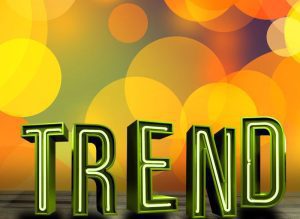Design trends change like the tide. Some trends, such as this year’s penchant for bright and bold colors, roll in and out periodically. Others are trends of the here and now, like the recent technological advances that allow for the addition of virtual reality and AI-generated art elements.
Whether you’re looking to update your company’s current branding or to put together some viral-worthy infographics, you need to know what designs are trending in the upcoming year and consider factoring these ideas into your own work.

(kalhh/Pixabay)
1. AI Art
A recent design trend, AI-generated art, can be seen everywhere. With the online generator DALL-E 2, anyone can create creative graphics simply by inputting natural language text descriptions.
While this art generation will add novelty to any design, there have already been red flags.
There are concerns that the art generated by DALL-E 2 is pulled from human-created art made by artists worldwide. This could cause major copywriting issues. While some may see AI art creation as an exciting technological advance or a way of democratizing art and design, some who earn their living as artists will surely disagree. Time will tell how long AI-generated art holds on as a graphic design trend.
2. Hand Drawn Elements
On the other side of the design spectrum from AI art, there is also a rising demand for hand-drawn design elements. With consumers voicing their desire for authenticity regarding brand advertising, a touch of hand-drawn and homemade fits the bill.
Hand-drawn illustrations add a feel of originality. They are unique and personal. No company wants its brand imaging to be associated with cookie-cutter, cheap, and interchangeable designs.
3. Video
The social media platform that is currently leading the pack is undoubtedly TikTok. Short-form videos and motion graphics are now imperative for any brand’s marketing strategy. Video has been on the hot trends lists for years and is not going anywhere.
According to the Washington Post, the average American spends 80 minutes on TikTok daily. Marketing professionals can integrate video elements into their content strategy in various ways. Short-form videos make great additions to infographic design. They can be added to company websites and inserted into newsletters, among many other options. Creating a TikTok and Instagram account for your business will also assist in sharing video content.
4. 3D and Virtual Reality
In another wave-of-the-future design trend, you will see many more 3D and virtual reality elements in 2023. Virtual reality has taken off with the pandemic in a push toward significant digitization of everything.
Graphic design has been affected by this push. In the coming year, you can expect to encounter futuristic image rendering, liquid gradients, 3D elements, and neon sci-fi-reminiscent palettes.
5. Bright Bold Design
Along with neons, bright, bold colors and abstract shapes will be all the rage. Think organic forms in fun, playful shades. Abstract, layered illustrations call to mind vintage artwork.
Color palettes are trending toward jewel tones in 2023. The past couple of years have been about calming, muted colors, but the upcoming year will showcase rich crimson reds, forest greens, and striking purples. We are ready for elegant, indulgent hues.
6. Inclusivity
Inclusive design has been a consumer concern and purchasing draw for the past few years. 2023 will see an even greater lean toward inclusivity. From the reverberations of the Black Lives Matter Movement to a cry for more varied gender depictions, we should see a higher degree of representation across the board in brand marketing.
For graphic design, this could mean things like sharing infographics that include illustrations and imagery representative of all races (including indigenous populations), all genders (including transgender and nonbinary people), and all ability levels.
7. Accessibility
Accessible or Universal Design has been on the rise in recent years. This design goes beyond visual representations of people of all abilities, as discussed above. Accessible design ensures that all consumers find design elements accessible and can feel that businesses and organizations value them.
Accessible design includes using easy-to-read fonts on your website, introducing braille to product packaging, including textual descriptions where you post infographics, and choosing high-contrast design elements to aid the visually impaired. There are many ways in which graphic design can be more accessible and inclusive.
The graphic design industry constantly evolves. While these top trends look to be popular in the upcoming year, only reflection at the end will prove their case. Technology and digitization are having a big moment and a significant impact on design possibilities. While AI-generated art, 3D components, and video currently dominate the art and design world, it is anyone’s guess what advancements will look like in the coming years. And while inclusion, representation, and accessibility are certainly trending, these concepts will likely transcend passing fads to become permanent elements of good design.
